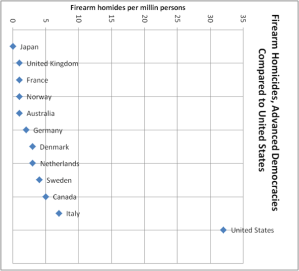On April 17, 2013, the US Senate held a vote on the Toomey-Mancini amendment to Senate Bill 659. The amendment would require finding out if people are insane or criminals and, if so, prevent them from getting guns. The idea is supported by over 80 percent of the US population.The bill was defeated by a vote of 55 in favor and 45 against, so it failed, because the majority in the US Senate has no power. 55% loses.Since Senators represent states and not people, a small state has as many Senators as a large one. Mostly small state Senators opposed background checks, so the rule by the minority was even smaller in population terms. An analysis of the vote shows that 29.2 percent of the US population was able to prevent majority rule. (Appendix A)
American gun crime is so high that the US does not qualify as a developed democracy.

(Appendix B)
One cause of gun death is the perversion of the Second Amendment, which is designed to promote the security needed for freedom, but has been misrepresented in order to maximize gun and bullet sales. This misrepresentation is possible because too many Americans know nothing about the issue and are easily panicked by their fears and paranoia.
Most people do not know what the Second Amendment says. It says, “A well regulated Militia, being necessary to the security of a free State, the right of the people to keep and bear Arms, shall not be infringed.”
Those who claim to understand the Second Amendment usually do not. One side claims it allows anybody to keep and bear arms; the other side, that the militia clause allows any regulation by government. Both views are false. Both sides err from their cultural bias and lack of understanding of history and logic. The gun nuts do not respect the constitutional requirement to regulate, and the gun controllers generally don’t like guns. They talk at each other, grabbing a hold of a partial truth, unable to see the genius of the amendment.
The two parts function as one, not as independent clauses. From the viewpoint of the Constitution, there is no right to bear arms except as part of a well regulated militia, and there can be no militia without a right of the people to keep and bear arms. Regulation and bearing arms are not opposed to each other; they exist because each is necessary to the other. The purpose of the militia is to secure freedom. The lack of a militia, or a poorly-regulated militia, cannot achieve the goal of securing freedom.
“Well-regulated” is what ties the militia to government. The Founders were aware, from Whiskey and Shays and other rebellions, that an unregulated militia was a threat to citizens and to government. Even today, right-wing militias give the militia idea a bad name. The concept, however, is not rooted so much in government as it is in the weakness of government and the need for citizens to play a role, in fact, an armed role. The concept assumes no split between people and government, but a unity of function, each needing the other. Relative success in achieving domestic tranquility since the Civil War has allowed these lessons to be forgotten, even when they have application today.
How do we know that such a militia is necessary for freedom? We know it is necessary because in America today we do not have a well-regulated militia, and it allows the loss of freedom in high crime areas and random gun violence elsewhere. It does not matter if a death is caused by foreign or domestic enemies. Our domestic enemies are the gun jihadists, who do not want a well-regulated militia. Out of control gun crime in some neighborhoods, murder after murder, suicides, accidental deaths, assassinations, and periodic mass killings of children are now far worse than in the days of the Early Republic.
The regulation would work two ways, keeping guns out of the hands of the unqualified, and as a rapidly mobilized force of volunteers to work with police when local crime gets out of control. The viability of this idea will vary from place to place, but something should be done to overcome the frustration and vulnerability of people, usually low income people, who live in high crime areas with violence that is not tolerated in developed countries. Something should be done to keep guns out of the hands of those unqualified to be in a militia, to at least reduce the frequency of random mass shootings.
In February, Robin Kelly won a Democratic primary in Chicago for a seat Congress with a pro-gun control position, defeating an anti-gun control candidate. She was helped by what most pro-security candidates have lacked, funds for an aggressive campaign on the issues. The pro-gun money has usually been able to make support for security toxic, but in Chicago the tables were turned. The new money came from a political fund established by New York Mayor Michael Bloomberg, turning the tables. People got the information they needed to vote in their self-interest.
Bloomberg has used his wealth to criticize Democratic Senators who voted against stronger gun laws when well over 60 percent of their constituents wanted them. Some of his fellow Democrats fear such attacks could cost the party seats in the Senate and loss of control. On the other hand, the value of Democratic control is vitiated by the unwillingness of the Democratic majority to use its votes to stop minority rule by the Republicans.
Past outrage over assassinations and mass shootings, and many years of serious efforts like the Brady Campaign to Prevent Gun Violence, have not been enough, and we do not know if Chicago is a turning point. But it can be, and it will take about six years of work from a much higher political base to restore the security required by the Constitution. Gun jihadist support for candidates needs to become politically toxic.
Progressive states need to experiment with militia concepts. Responsible gun owners need to establish state advocacy groups to promote the Second Amendment, and to teach the genius behind its wording, its value to the Early Republic, how it fell into decay, and how gun jihadists have tried to brainwash Americans into opposing their own Constitution. We can restore the pride people once felt to keep and bear arms in a well-regulated militia, people like my ancestor Lieutenant Reuben Doty (1745—c1820) of Colonel Humphrey’s regiment, and my Great Grandfather John Gilman McAllister, Assistant Surgeon of the Fourth Battery of Light Artillery in the Second Brigade, First Division, Massachusetts Militia.
Given the cultural power of those passionately trying to use the Constitution to undermine it, progress over the next few years is likely to be minimal. The great majority usually fails to vote the way it feels. Responsible gun owners have a difficult row to hoe: they will not be appreciated by those who don’t like guns, and they will be attacked by other gun owners. Any organization may be slandered as an unregulated militia, yet there is no governmental support for a regulated militia. The idea that the National Guard is somehow the militia is inconsistent with the Constitution, because citizens should not be expected to be in the National Guard.
A well regulated militia could be part of an effort to deal with crime in high crime areas. It may seem counter-productive to have more arms in an area where guns are out of control, but there are a couple of counter-considerations: the gangs associated with guns are greatly out-numbered by old adults who now have no armed framework for action, and enforcement of regulation would remove guns from the irresponsible.
A well regulated militia would by its nature not allow an uncontrolled proliferation of weapons and bullets. Such controls are usually thought of in the context of control, but properly implemented they strengthen the effectiveness of citizens to keep and bear arms. It makes no sense to arm citizens and then also arm the criminal element they are supposed to fight, or to arm the mentally ill and unstable. The framing problem has been that control measures are seen as controlling guns, rather than as a citizen militia effective. Militia-based gun control is required by the Constitution.
We need not honor every decision of the Founders. They themselves were uncertain as to what would work and what not. They made compromises, like slavery and limited suffrage, that have not stood the test of time. However, in the case of the Second Amendment, citizen ownership of Arms is today still very much a recognized right, and the need for security is as great to deal with domestic enemies as it was when the amendment it was adopted to deal with foreign enemies. The Founders showed wisdom in exactly how they framed the idea. It is time we honored the intent of the Founders. It is a matter of regulation and freedom, and of pragmatism and patriotism.
Appendix A
This tally puts Sen. Reid as a yes because his shift to no before close of voting was a parliamentary maneuver to preserve the right to move for reconsideration.



